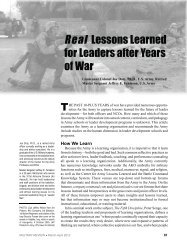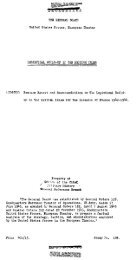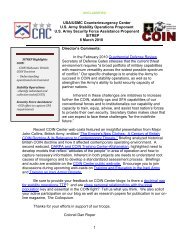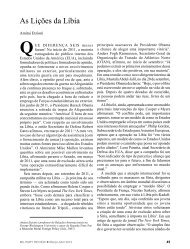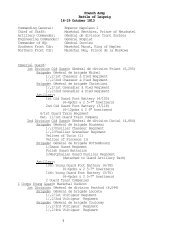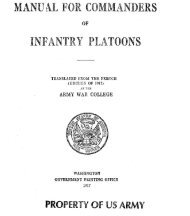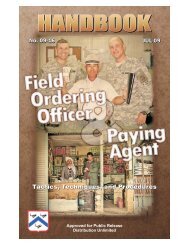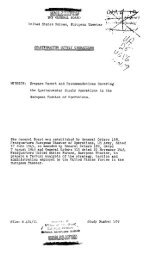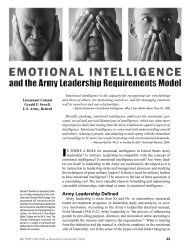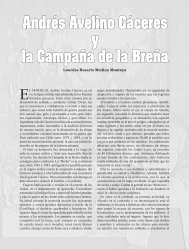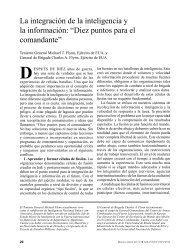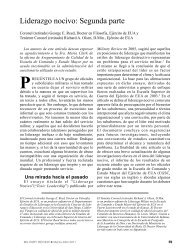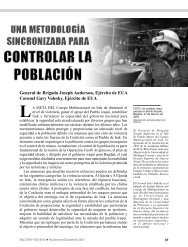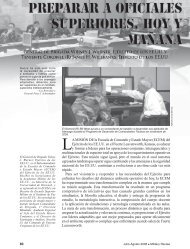Armor Magazine Counterinsurgency Selected Works - US Army
Armor Magazine Counterinsurgency Selected Works - US Army
Armor Magazine Counterinsurgency Selected Works - US Army
You also want an ePaper? Increase the reach of your titles
YUMPU automatically turns print PDFs into web optimized ePapers that Google loves.
Evolution takes analysis and relies on the military historian to<br />
provide the analysis and research in any conflict. Conflicts or war<br />
can be grouped or categorized in various ways. My instructional<br />
education has taught me the difference between “total war” and<br />
“limited war.” “Total war,” as described by Dennis Showalter in<br />
Lecture 9 of Introduction to Military History, is “generally understood<br />
as war in which resources, human and materiel, of the<br />
combatants are committed to a conflict, admitting neither rules<br />
nor restraints in military operations, and the outcome of which<br />
places the defeated entirely at the mercy of the victor.” 1 In this<br />
short definition of total war, we see two sides committed to a<br />
particular conflict who will stop at nothing to accomplish their<br />
aims. There is no operational, logistical, or human expense that<br />
will be spared to accomplish either participant’s desired end<br />
state. An example of this particular type of warfare is World War<br />
II. Conflicts, such as Vietnam and the Revolutionary War, take<br />
on many traits of “total war,” but in many ways, it is a contest of<br />
“David vs. Goliath.”<br />
Insurgent warfare is a limited war, a contest of the weak versus<br />
the strong. The struggle is seen as an internal conflict, which involves<br />
a conflict between a government and an opponent who<br />
wants to bring about change in the current political setting through<br />
political or violent means. As Robert Tabor discusses in War of<br />
the Flea: The Classic Study of Guerrilla Warfare, there are four<br />
political aspects that insurgents attempt to challenge during any<br />
particular insurgency: integrity of the borders and composition<br />
of the nation state; the political system; authorities in power;<br />
and the policies that determine who gets what in society. 2 The insurgency<br />
is asymmetrical in nature and the tactics used to bring<br />
about change need to be understood — both sides in this type<br />
of warfare have differing capabilities. Dennis Showalter, in Lecture<br />
10 of Introduction to Military History, describes it as one opponent<br />
trailing the other because it cannot match its enemy in<br />
“In this short definition of total war, we see two sides committed to a particular conflict<br />
and will stop at nothing to accomplish their aims. There is no operational, logistical, or<br />
human expense that will be spared to accomplish either participant’s desired end state.<br />
An example of this particular type of warfare is World War II. Conflicts, such as Vietnam<br />
and the Revolutionary War, take on many traits of “total war,” but in many ways, it is a<br />
contest of ‘David vs. Goliath.’ ”<br />
the areas of technology or instructional learning. 3 This gap must<br />
be bridged; therefore, insurgents must use asymmetric tactics of<br />
terrorism and guerrilla warfare.<br />
More often than not, insurgencies are confused with the tactics<br />
used to further their objectives. Terrorism and guerrilla warfare<br />
tactics are commonly used; insurgents may use both or neither<br />
of these tactics, however, they are not the overarching principle<br />
of the conflict. Terrorism is described as “the threat or use of<br />
physical coercion against noncombatants to create fear to achieve<br />
political objectives;” guerrilla warfare uses hit-and-run tactics<br />
against police, military, and physical infrastructures that support<br />
the legitimate government. 4 The tactical success of an insurgency<br />
depends on the strategic plan of the insurgent, which depends<br />
on five key factors for success. Robert Tabor defines these factors<br />
as the “will to maintain the revolt; the mindset to avoid the<br />
state’s strengths and attack its weaknesses; the metamorphosis<br />
of the protracted armed struggle from the strategic defensive, to<br />
the strategic stalemate, to the strategic offensive; the role the political<br />
organization plays in gaining and maintaining support for<br />
the insurgency; and the government’s counteraction against the<br />
insurgency. Does the government use discriminate force or indiscriminate<br />
force when dealing with the enemy? The center of<br />
gravity, or the civilian populace, that is on the fence could decide<br />
to support the insurgency if the government uses violent means<br />
against them.” 5<br />
The five strategic aspects of this particular struggle show that<br />
the typical insurgent needs to be endeared to the general public<br />
to proliferate. The internal conflict needs to be balanced between<br />
guerrilla, terrorism, and political tactics to be successful. The<br />
ordinary civilian caught in the middle between government and<br />
insurgent forces should be the main objective of insurgent or<br />
counterinsurgent operations. Civilians are the center of gravity<br />
and the aspect of this particular struggle<br />
that can tip the favor from one side to another,<br />
thus enabling insurgents to recruit<br />
local citizens to join the insurgency, and encouraging<br />
the local populace to support the<br />
insurgency by providing a base of operations<br />
or hospitality to the insurgent, as well<br />
as financial and other means of support.<br />
Support is vital to any insurgency, as proven<br />
during the Vietnam War when South<br />
Vietnamese villagers provided support to<br />
the Viet Cong. This insurgent army blended<br />
in with the population, which allowed<br />
them to recruit from within villages and<br />
maintain power, even when they were decisively<br />
engaged by government forces.<br />
Weapons and supplies were easily cached<br />
in villages and stored in intricate cave systems.<br />
In turn, this meant that logistics and<br />
medical support came from these villages,<br />
thereby fueling the insurgency. The fact<br />
that the Viet Cong and North Vietnamese<br />
army won over the center of gravity led<br />
South Vietnamese and U.S. forces to begin<br />
a campaign of clearing villages known<br />
to harbor such insurgents. This campaign<br />
effectively denied the insurgency its center<br />
of gravity.<br />
The center of gravity, or people, support<br />
insurgencies because they see the government<br />
failing them in two key areas: security<br />
and basic services. These two key fac-<br />
40 — September-October 2008



